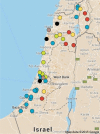Prevalence, Risk Factors, and Transmission Dynamics of Extended-Spectrum-β-Lactamase-Producing Enterobacteriaceae: a National Survey of Cattle Farms in Israel in 2013
- PMID: 26311861
- PMCID: PMC4609711
- DOI: 10.1128/JCM.01915-15
Prevalence, Risk Factors, and Transmission Dynamics of Extended-Spectrum-β-Lactamase-Producing Enterobacteriaceae: a National Survey of Cattle Farms in Israel in 2013
Erratum in
-
Correction for Adler et al., Prevalence, Risk Factors, and Transmission Dynamics of Extended-Spectrum-β-Lactamase-Producing Enterobacteriaceae: a National Survey of Cattle Farms in Israel in 2013.J Clin Microbiol. 2016 Jun;54(6):1671. doi: 10.1128/JCM.00665-16. J Clin Microbiol. 2016. PMID: 27217387 Free PMC article. No abstract available.
Abstract
Our objectives were to study the prevalence, risk factors for carriage, and transmission dynamics of extended-spectrum-β-lactamase (ESBL)-producing Enterobacteriaceae (ESBLPE) in a national survey of cattle. This was a point prevalence study conducted from July to October 2013 in Israel. Stool samples were collected from 1,226 cows in 123 sections on 40 farms of all production types. ESBLPE were identified in 291 samples (23.7%): 287 contained Escherichia coli and 4 contained Klebsiella pneumoniae. The number of ESBLPE-positive cows was the highest in quarantine stations and on fattening farms and was the lowest on pasture farms (P = 0.03). The number of ESBLPE-positive cows was the lowest in sections containing adult cows (age, >25 months) and highest in sections containing calves (age, <4 months) (P < 0.001). Infrastructure variables that were significant risk factors for ESBLPE carriage included crowding, a lack of manure cleaning, and a lack of a cooling (P < 0.001 for each), all of which were more common in sections containing calves. Antimicrobial prophylaxis was given almost exclusively to calves and was associated with a high number of ESBLPE carriers (P < 0.001). The 287 E. coli isolates were typed into 106 repetitive extragenic palindromic (REP)-PCR types and mostly harbored blaCTX-M-1 or blaCTX-M-9 group genes. The isolates on the six farms with ≥15 isolates of ESBLPE were of 4 to 7 different REP-PCR types, with one dominant type being harbored by about half of the isolates. Fourteen types were identified on more than one farm, with only six of the farms being adjacent to each other. The prevalence of ESBLPE carriage is high in calves in cowsheds where the use of antimicrobial prophylaxis is common. ESBLPE disseminate within cowsheds mainly by clonal spread, with limited intercowshed transmission occurring.
Copyright © 2015, American Society for Microbiology. All Rights Reserved.
Figures



References
-
- Reist M, Geser N, Hächler H, Schärrer S, Stephan R. 2013. ESBL-producing Enterobacteriaceae: occurrence, risk factors for fecal carriage and strain traits in the Swiss slaughter cattle population younger than 2 years sampled at abattoir level. PLoS One 8:e71725. doi:10.1371/journal.pone.0071725. - DOI - PMC - PubMed
MeSH terms
Substances
LinkOut - more resources
Full Text Sources
Medical

